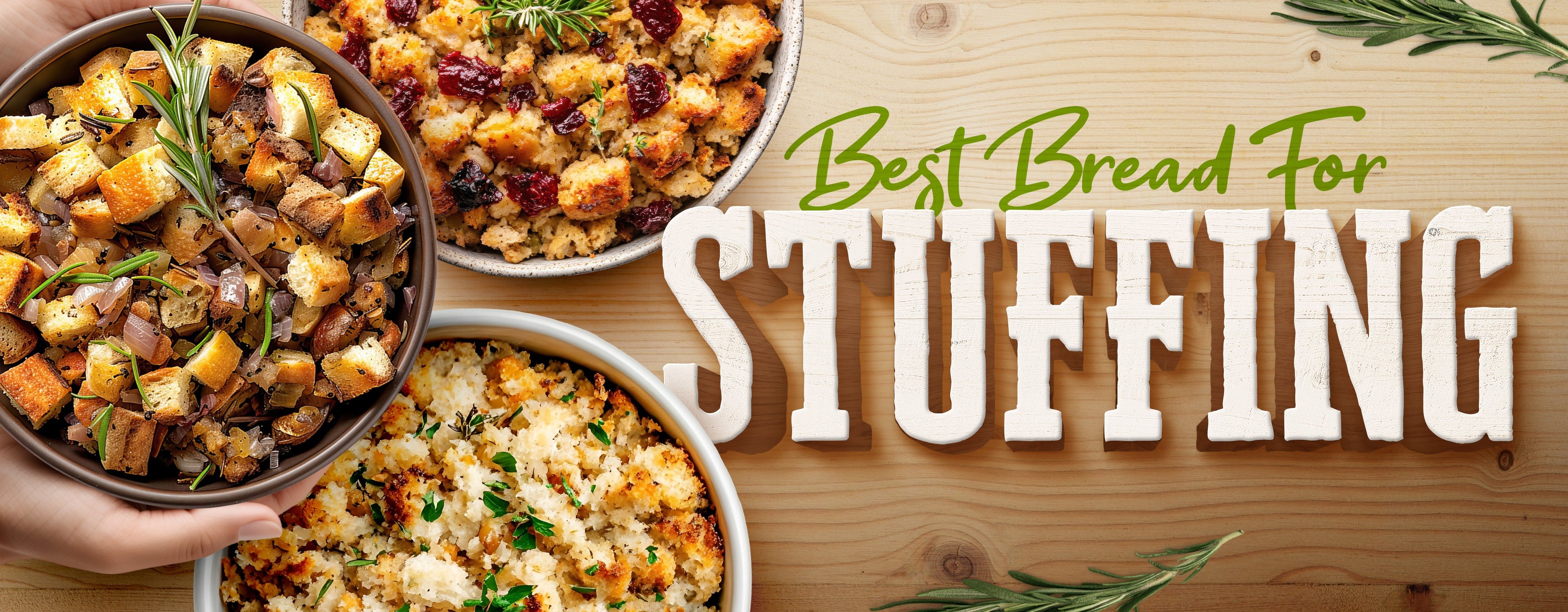The best bread for stuffing is a sturdy, dry loaf that soaks up broth without collapsing, thereby creating the perfect balance of tenderness and texture. Since the foundation of any great stuffing recipe starts with the bread, choosing the right type of bread is the most critical step for foodservice operators. Below, we detail the most popular breads for stuffing, from classic French to rich brioche, providing the essential starting point for building your signature holiday stuffing.
What Is Stuffing?
Stuffing is a savory dish consisting of bread, aromatics, herbs, and stock that is either baked inside poultry or prepared as a separate casserole. For foodservice operators, it's an essential holiday menu item that requires careful planning for batch production and consistency. Mastering this dish hinges on understanding its core components, beginning with the selection of the right bread to build upon.
1. Italian Bread

Italian bread, with its crisp, sturdy crust and moderately open crumb, is a workhorse choice for high-volume stuffing production. Its robust structure stands up to vigorous mixing and absorbs stocks and dressings without losing its defining texture. This reliability ensures consistent results batch after batch, making it a practical and efficient foundation for stuffing recipes in a commercial operation.
- Flavor Profile: Creates a savory, wheat-forward foundation that readily accepts and enhances the flavors of herbs, garlic, and aromatics. Classic, versatile stuffing that pairs well with a wide range of proteins without overshadowing them.
- Allergens: Gluten
2. French Bread

Some of the best bread for stuffing is often French bread, specifically a classic baguette or batard, due to its ideal structural properties. Its crisp, firm crust provides necessary resilience, while the airy, open crumb offers maximum surface area for absorbing stocks, butter, and pan drippings without becoming waterlogged. This combination ensures a finished stuffing with a defined texture that holds its shape on the steam table. For kitchen efficiency, French bread stales quickly, which expedites prep and guarantees consistent absorption across large batches.
- Flavor Profile: Imparts a mild, slightly yeasty tang that forms a neutral yet flavorful base, allowing rich stocks, fresh herbs, and added ingredients like sausage or mushrooms to be the starring elements.
- Allergens: Gluten
3. White Sandwich Bread
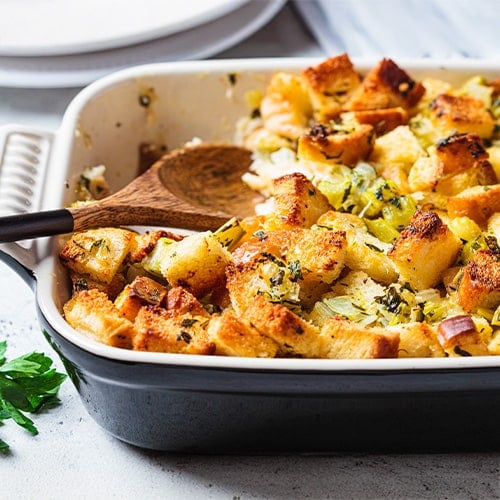
White sandwich bread is a top contender for stuffing due to its unparalleled consistency and availability, making it a logistically sound choice for high-volume foodservice operations. Its ultra-soft, fine crumb dissolves evenly into a tender consistency that appeals to a broad customer base, particularly those who prefer a more uniform stuffing. While its high moisture content requires thorough drying to prevent mushiness, this quality also allows it to absorb rich fats and seasonings deeply. Its neutral taste and soft texture also make it an excellent base for specialty stuffing, such as those pureed for a smoother side dish option.
- Flavor Profile: Yields a very mild, buttery, and comforting taste that acts as a blank canvas, making it ideal for highlighting premium additions like truffle and fresh sage.
- Allergens: Gluten, may contain soy, and some brands include dairy/egg
4. Challah

Challah's rich, egg-enriched composition delivers a uniquely luxurious foundation for stuffing, setting it apart from plainer breads. Its tight, tender crumb and soft texture absorb custard-like liquid blends exceptionally well, yielding a final product that is moist, rich, and cohesive with a subtle sweetness. The bread's inherent richness means you can often use a slightly less fatty stock or broth without sacrificing flavor depth or a moist mouthfeel. For operators, its sturdy braided loaves cube cleanly and stale efficiently, making prep straightforward for creating a premium, signature stuffing option.
- Flavor Profile: Imparts a distinct, slightly sweet, and buttery flavor that pairs exceptionally well with apples, dried fruits, nuts, and savory herbs like rosemary, creating a complex side dish that can command a higher menu price.
- Allergens: Gluten, eggs, and may contain dairy
5. Bagels
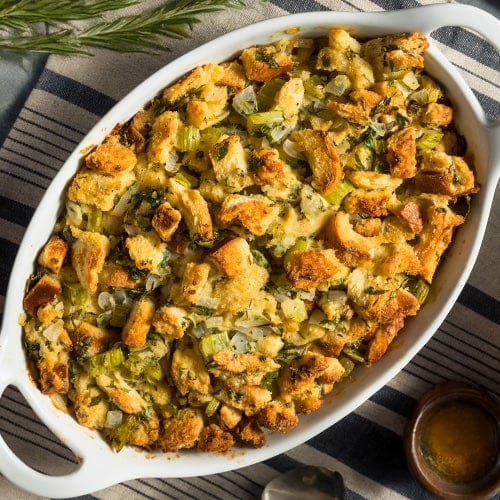
Using day-old bagels is a strategic move for foodservice operators seeking to minimize waste while maximizing texture in their stuffing. Their incredibly dense and chewy crumb provides unmatched structural integrity, resisting sogginess even when combined with rich stocks for extended periods on a steam table. This density requires slightly longer soaking times or a finer cube, but rewards with a distinctly hearty, substantive final product that holds a clean cut when portioned. Leveraging different types of bagels like plain, sesame, or everything bagels from breakfast service transforms them into a cost-effective stuffing base.
- Flavor Profile: Delivers a malty, robust wheat flavor with a satisfyingly chewy texture. Everything or onion bagels contribute pronounced savory notes of garlic, poppy seed, and sesame that infuse the entire dish, reducing the need for additional seasonings.
- Allergens: Gluten. May contain sesame, poppy, and dairy depending on the variety
6. Sourdough Bread

Sourdough bread offers a distinct advantage for stuffing with its complex flavor profile and structural resilience. Its characteristic tang provides a built-in flavor foundation that cuts through the richness of stocks and fats, creating a more sophisticated taste experience. The robust, chewy crumb and sturdy crust hold up exceptionally well to moisture, ensuring the stuffing maintains a defined texture rather than becoming mushy. This makes it an ideal choice for operators looking to create a premium, artisanal stuffing that stands out on a holiday menu and performs reliably during high-volume service.
- Flavor Profile: Provides a pronounced, tangy acidity and deep wheat notes that pair exceptionally well with roasted mushrooms, sausage, sage, and thyme, creating a stuffing with a complex, savory character that requires less additional seasoning.
- Allergens: Gluten
7. Cornbread
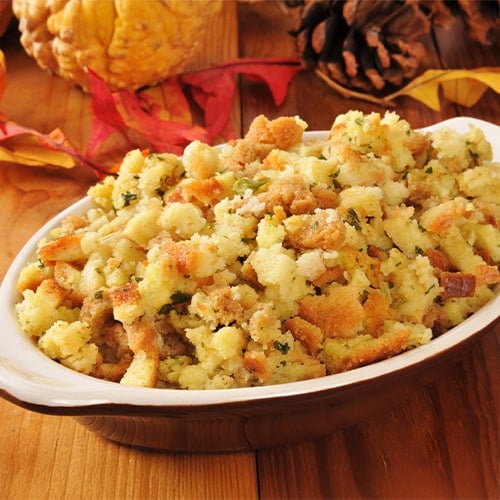
Cornbread stands out for stuffing by contributing a uniquely moist, crumbly texture and a sweet, savory flavor that defines Southern-style dressings. Its gritty yet tender crumb absorbs stocks and pan drippings efficiently while maintaining a distinct identity, avoiding the pasty consistency that can plague stuffing made with finer breads. The inherent sweetness of cornbread provides a natural counterpoint to savory herbs, spicy sausage, and aromatic vegetables, creating a complex flavor profile with minimal additional seasoning. Preparing cornbread in sheet pans specifically for stuffing ensures consistent texture and simplifies large-batch production.
- Flavor Profile: Offers a sweet, buttery corn flavor with a toasted undertone that pairs exceptionally well with smoky bacon, spicy peppers, sage, and thyme.
- Allergens: Gluten (if made with wheat flour), eggs, and dairy
8. Brioche
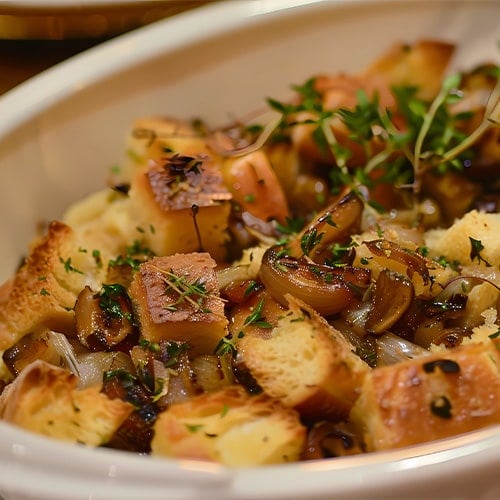
Brioche offers a decadent foundation for stuffing, creating a dish with an exceptionally rich, buttery character that appeals to upscale menus. Its high egg and butter content yields a tender crumb that absorbs liquids slowly, resulting in a luxuriously moist and cohesive stuffing with a delicate texture. While its inherent richness requires careful balancing with savory stocks and herbs to prevent an overly heavy result, it provides a natural flavor complexity that elevates the entire dish. Brioche's structural softness means it requires less drying time than crusty breads, though its premium cost makes it best suited for signature or holiday-specific offerings.
- Flavor Profile: Imparts a pronounced sweetness and rich, buttery flavor that pairs exceptionally well with prunes, roasted chestnuts, apples, and savory herbs like tarragon, creating a sophisticated sweet-savory balance.
- Allergens: Gluten, eggs, dairy, and sometimes soy
9. English Muffin
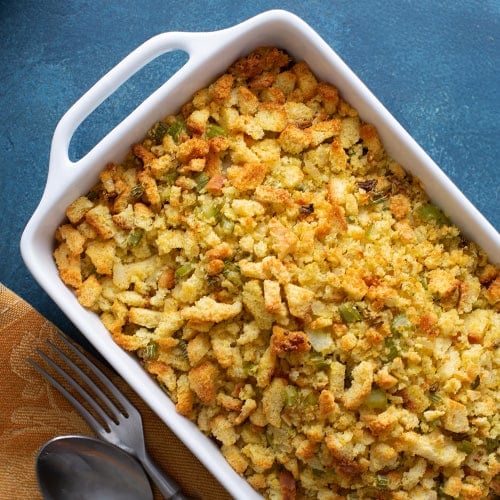
English muffins provide a uniquely efficient base for stuffing, leveraging their signature nooks and crannies for exceptional broth absorption. Their dense yet soft structure maintains integrity during mixing and baking, resulting in a stuffing with a pleasingly tender bite that holds its form on the steam table. This makes them an excellent choice for operators seeking to utilize day-old breakfast items, reducing waste while creating a distinctive side dish. Their pre-portioned size and consistent quality from suppliers also streamline prep work, allowing for quick cubing and minimal preparation time during high-volume periods.
- Flavor Profile: Delivers a subtle, slightly tangy maltiness and toasted notes that provide a neutral yet characterful backdrop for herbs like sage and thyme, allowing additions like cheese or sausage to remain the focal point.
- Allergens: Gluten, may contain dairy, whey, soy, and egg
10. Cuban Bread
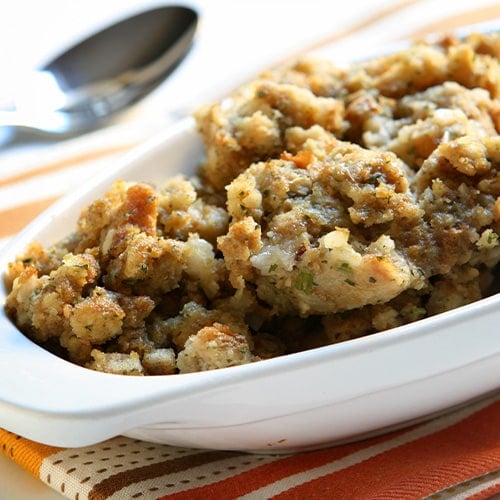
Cuban bread offers a distinctive choice for stuffing with its unique combination of a deceptively thin, crisp crust and a soft interior. The crust provides just enough structure to prevent sogginess, while the tender crumb readily soaks up flavorful marinades, citrus-infused stocks, or poultry drippings. This makes it particularly well-suited for operators creating stuffing with Latin-inspired flavors or seeking a lighter alternative to denser breads. Its traditional formulation with lard or oil also contributes to a moist final product that holds up well during extended service.
- Flavor Profile: Provides a mild, slightly sweet backbone with a subtle tang that complements citrus, garlic, cumin, and oregano exceptionally well, creating a stuffing that pairs perfectly with pork or citrus-marinated poultry.
- Allergens: Gluten and lard (dietary restrictions)
Stuffing vs Dressing
The primary difference between stuffing and dressing is the cooking method: stuffing is traditionally cooked inside the cavity of poultry, while dressing is baked separately in a casserole dish. In a commercial kitchen, the term "dressing" is often preferred for menu description and food safety reasons, as cooking a starch inside poultry can present challenges with even heating and cross-contamination. Regardless of the name, the foundational principles for an excellent dish remain the same.
What Makes a Good Bread for Stuffing?

The ideal bread for stuffing provides structural integrity, allowing it to absorb a significant amount of liquid and fat without disintegrating into mush. This creates a final product with a pleasing texture that holds its shape when portioned. For high-volume service, the bread must be consistent, readily available, and processed efficiently to save on labor costs.
- Sturdiness and Structure: A robust crumb with a tight or firm texture is essential. Delicate, ultra-soft breads will turn to paste when mixed with stock, resulting in a soggy, unappealing stuffing that is difficult to plate cleanly.
- Low Moisture Content: Slightly dry or stale bread is ideal. Dry bread acts like a sponge, soaking up the seasoned broth and melted fats, where the flavor development occurs. This staling process can be accelerated for consistency by cubing fresh bread and toasting it in a low oven.
- Neutral or Complementary Flavor: The bread should serve as a canvas for the other ingredients. A neutral base allows the flavors of herbs, stock, and aromatics to shine, while a bread like sourdough or cornbread can actively complement and enhance the overall flavor profile of the dish.
- Good Absorption Qualities: The bread needs to absorb enough liquid to become tender and moist throughout the baking process without leaking it back out. This absorption is what creates the custard-like consistency that defines a perfectly executed stuffing.
Ultimately, selecting the ideal bread is the foundational step to building a standout stuffing that balances superior texture with deep, developed flavor. From the reliable neutrality of French bread to the rich complexity of brioche or cornbread, each variety offers a unique path to a signature dish that can define a holiday menu. Mastering this choice empowers operators to consistently produce a premier side that maximizes customer happiness, leaving patrons satisfied every time.
